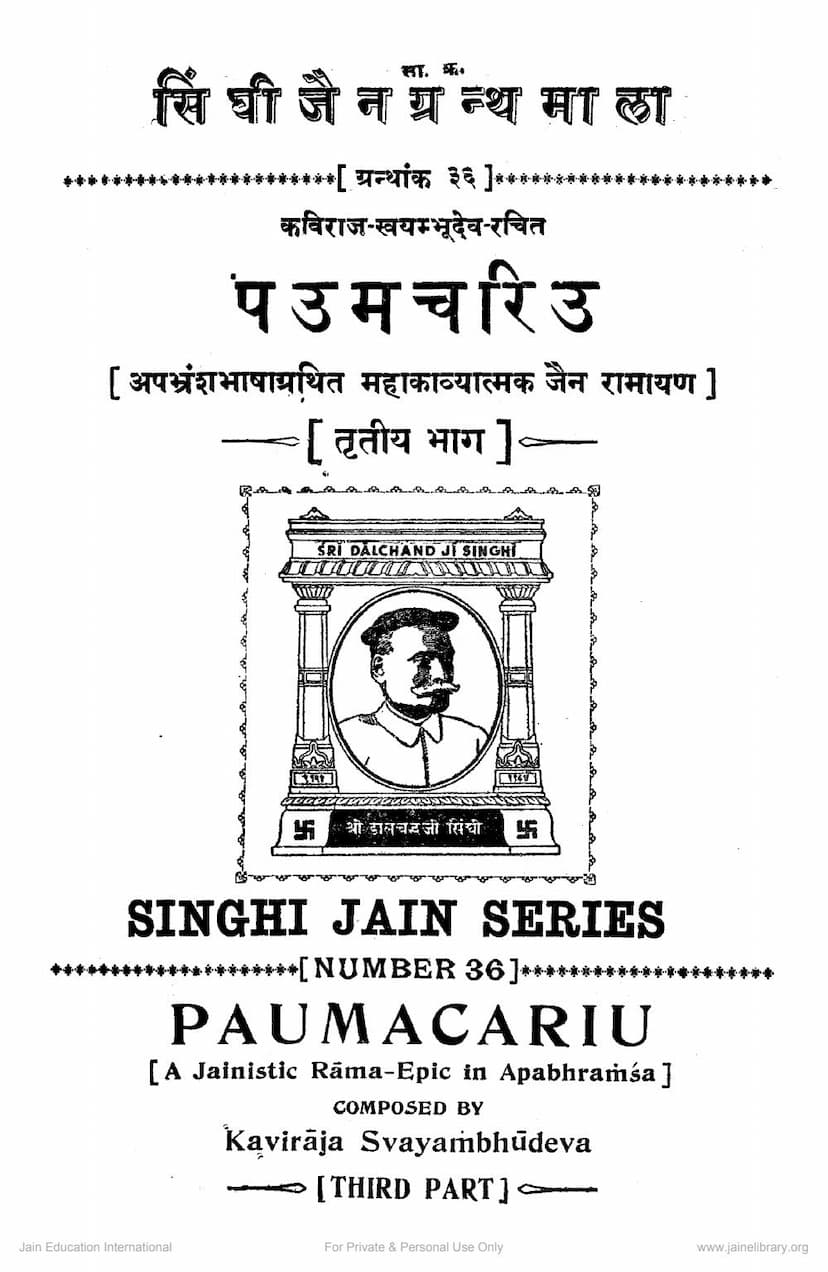Paumchariu Part 3
Added to library: September 2, 2025

Summary
Here's a comprehensive summary of "Paumacariu Part 3" based on the provided text:
Title: Paumacariu Part 3 (Pauṁacariu Part 3) Author: Kavirāja Svayambhudeva Editor: Dr. Harivallabh Chimanlal Bhayani Publisher: Singhi Jain Sastra Siksha Pitha, Bharatiya Vidya Bhavan, Bombay Series: Singhi Jain Series, Volume No. 36 Publication Year: Vikram Samvat 2016 (AD 1960)
Overview:
"Paumacariu Part 3" is the third and final installment of the critically edited Apabhramsa epic "Paumacariu" (also known as Jainistic Rāma-Epic). This volume contains the Yuddha Kāṇḍa (Chapters LVII-LXXVII) and the Uttara Kāṇḍa (Chapters LXXVIII-XC) of Svayambhudeva's monumental work. It completes the publication of the earliest available Apabhramsa Purāṇic epic, which is highly significant for its literary, linguistic, and culture-historical value.
Key Sections and Contents:
The book is structured with extensive introductory materials and the text of the epic itself, followed by appendices.
1. Introduction (Pages 7-46): Dr. H. C. Bhayani's introduction provides a detailed analysis of the Yuddha and Uttara Kāṇḍas.
-
Narrative Outline (Sandhis LVII-XC):
- Yuddha Kāṇḍa (Sandhis LVII-LXXVII): This section covers the escalating conflict between Rāma and Rāvaṇa. It begins with Vibhīṣaṇa's defection to Rāma, Angada's peace mission, the description of both armies, and the fierce battles. Key events include the fall of Hasta and Prahasta, the valorous actions of generals from both sides, the capture and release of Sugrīva and Bhāmandala, Lakṣmaṇa being struck by a Śakti missile, the story of Viśalyā and Lakṣmaṇa's revival, Rāvaṇa's unsuccessful attempts at conciliation, the Nandiśvara festival, Rāvaṇa's acquisition of the Bahurūpiṇī power, his temporary change of heart, the final battle, Rāvaṇa's fall, and the lamentations and cremation of Rāvaṇa.
- Uttara Kāṇḍa (Sandhis LXXVIII-XC): This part deals with the aftermath of the war and the subsequent events in Rāma's life according to Jain tradition. It includes:
- Reunion with Sītā and the triumphant entry into Lankā.
- Vibhīṣaṇa's coronation as king of Lankā.
- Rāma's departure for Ayodhyā and Kāma's display of the land.
- Bharata's renunciation of the world.
- Satrughna's conquest of Mathurā.
- Sītā's exile and the birth of Lavaṇa and Añkusa.
- The exploits of Lavana and Añkuśa, and their conflict with Rāma and Lakṣmaṇa.
- Sītā's ordeal by fire and her subsequent renunciation.
- Detailed accounts of the previous births of the principal characters, providing a framework for their current incarnations and the unfolding of karmic consequences.
- The renunciation of Kṛtāntavaktra.
- The fate of Bhāmandala and Hanumat.
- Lakṣmaṇa's death upon hearing of Rāma's supposed death and his rebirth.
- Rāma's grief, loss of reason, and eventual renunciation.
- Rāma's attainment of omniscience and subsequent liberation (Nirvāṇa).
- The destinies of other significant characters like Dasaratha, Lavaṇa, Ankusa, Indrajit, and Ghanavāhana are also narrated.
-
Metrical Analysis: The introduction includes a comprehensive analysis of the various metres used in the Paumacariu, particularly in Sandhis LVII-XC, categorized into:
- Metres of the Kaḍavaka-commencing piece.
- Metres of the Yamakas or the main body of the Kaḍavaka.
- Metres of the Ghaṭṭā or Kaḍavaka-closing piece.
- It also details the variation metres and repetitive metres employed by Svayambhū, drawing comparisons with his other work, "Riṭṭhaṇemicariu."
-
Miscellanea:
- Find of another Tippaṇa on the Paumacariu: This section discusses a newly discovered manuscript of a commentary (Tippaṇa) on the Paumacariu, its characteristics, and its value in understanding the text and its glosses.
- Works ascribed to Svayambhu: The commentary provides clues about Svayambhu's other literary works, including grammars, prosody, and the Mahābhārata or Harivaṁśa Purāṇa.
- Find of another MS. of the Svayambhūcchandas: The discovery of fragments of Svayambhu's prosody work from a Tibetan monastery is discussed, confirming its treatment of Prakrit metres and providing new citations.
- A stotra by Svayambhu: The identification of an Apabhramśa stotra from a manuscript leaf, likely authored by Svayambhu, is presented.
- Svayambhu's Date: New evidence from the PC. text, referring to the Seuna country and the river Bhīmarathī, helps to refine Svayambhu's dating to approximately AD 840-920, placing his literary activity in the latter half of the 9th century.
- Caturmukha and Svayambhu: The introduction revisits the connection between Caturmukha's works and citations in Svayambhūcchandas, strengthening the argument for Caturmukha's influence.
2. Text of the Paumacariu (Pages 1-292): This section contains the critical edition of Sandhis LVII to XC (Yuddha Kāṇḍa and Uttara Kāṇḍa), based on multiple manuscripts with variants noted. The text is presented in Apabhramsa.
3. Appendices:
- Appendix I: Conspectus of the metres of Sandhis 1-90: A comprehensive list and classification of all the metres used in the Paumacariu.
- Appendix II: Metres of Svayambhu's Riṭṭhaṇemicariu: A comparative study of the metres employed in Svayambhu's other major work.
- Appendix III: Text of the stotra of Svayambhu: The Apabhramsa stotra identified in the introduction.
- Appendix IV: Tippaṇa for Sandhis 1-67(5): A collection of noteworthy glosses from the anonymous commentary manuscript.
Significance:
This volume is crucial for scholars of Jain literature, Indian epics, Apabhramsa language, and medieval Indian culture. It provides the complete text of the epic, making it accessible for in-depth study and analysis. The critical edition, along with the extensive introduction and appendices, represents a significant contribution to the field. The publication was made possible by the patronage of the Singhi family, in memory of Seth Sri Dalchandji Singhi, and with support from the Ministry of Scientific Research and Cultural Affairs, Government of India.
The work is dedicated to Acharya Jinavijaya Muni, acknowledging his profound influence and guidance.